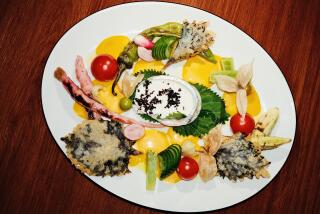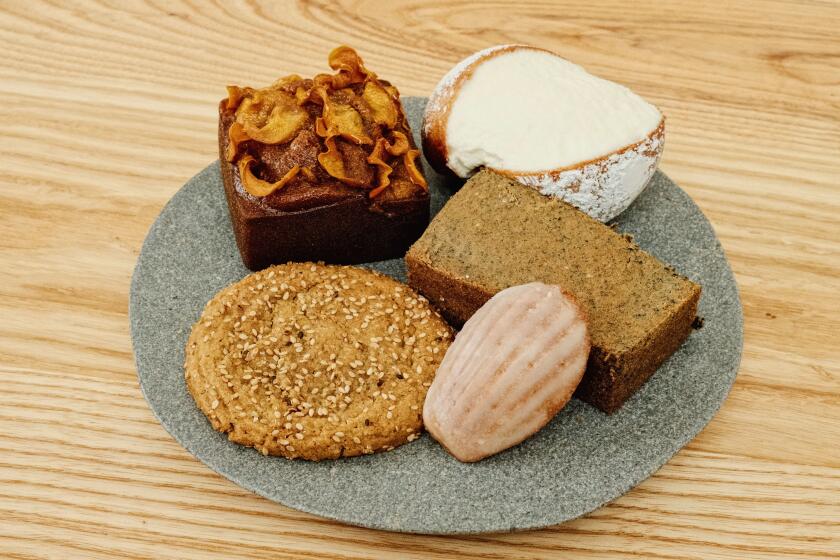Holding nothing back
IMAGINE spending hundreds of dollars to dine in a trendy restaurant, and being served a salad of rock-hard, tasteless tomatoes or a bananas flambe made with green bananas. Oddly, though, that’s what happens all too often with the wine: Most restaurants pour hard, tannic reds that really need a few years of bottle age before they’re ready to drink. Almost none offer a selection of mature wines.
Most restaurant wine lists are made up almost entirely of new releases, to the point at which they resemble retail inventories. Yet a retailer is sending wine home with the customer, who at least has the option of laying the bottles down to let time work its softening, mellowing magic. The restaurateur is serving the wine immediately.
A meal in a restaurant happens right now. The food arrives at the table ready to eat. Shouldn’t the wine be ready to drink?
Yes and no, say restaurant wine buyers.
“It’s expensive, and there’s not a huge return,” says Rick Jones of Valhalla Restaurant in Sausalito, Calif. “The margin is so small that adding additional inventory is too much. You have to have next year’s wines now, without an immediate return. I don’t think it’s fair to ask restaurants to do that.”
Jones agrees that a wine list should offer some mature wines. As the manager and wine buyer for Greens at Fort Mason in San Francisco for more than a decade, he made a point of maintaining a large inventory that allowed him to add wines to the list as they reached optimum drinkability. That did not go unnoticed by wine lovers, who flocked to the restaurant during the ‘90s to eat chef Annie Somerville’s vegetarian cuisine with beautifully mature, reasonably priced wines.
But that cellaring program was expensive, he says, and caused constant friction with the restaurant’s owners. “Our inventory was $100,000, and the owners wanted it to be a third of that. I fought that every day.”
Jones and his partner in Valhalla, Master Sommelier Nunzio Alioto, still recognize the need for some older wines on the list. So they raid their own cellars to supply them. “Fortunately, we both have deep cellars and were able to stock the restaurant with some older Cabernets, Bordeaux and Pinots from there. We also started planning the cellar early, before we opened, and were able to have some suppliers hold wines for us until we had the funds to pay for them. But you can’t do that all the time.”
Debbie Zachareas, managing partner and wine buyer at Bacar in San Francisco, agrees that a restaurant should offer mature wines -- and that the cost is prohibitive. “My personal decision is to just offer everything, and not decide for the customer that they should wait until this wine is mature. There are a lot of people who like to drink young wines. If that’s what they want, then the wine will sell. If not, then it naturally becomes older.”
Bacar is one of the most wine-intensive restaurants in the country. Zachareas says her wine inventory is about $250,000, with about 1,200 selections. There’s no room in the budget or the cellar to age wines, she says. “I would rather buy what’s current and offer that, and then supplement my list with wines that are already aged.” She works her extensive network of contacts to procure older wines on the secondary market, and prices them to move.
And she notes that those mature wines account for some of the fastest turnover on the list. “Lately I’m seeing a great demand for Bordeaux from the ‘70s and ‘80s,” she says. “A lot of it is investment banker types from the East who are used to drinking Bordeaux. They look at the prices and say, ‘Why drink an overpriced California cult wine when I can get an older Bordeaux for the same price, or less?’ I’ll get some ’66 Lynch Bages or ’78 Ducru Beaucaillou in on Friday, and it will be gone by Sunday.”
A well-aged Bordeaux is perfect table wine -- smooth and harmonious, with vibrant flavor and supple texture and the bright acidity that complements food so well, all in the context of a civilized alcohol level. By contrast a big, young red wine, especially California Cabernet, can be entirely overwhelming.
Oh, it may seem voluptuous and soft at first glance, but after a few sips the concentrated tannins and acids kick in and begin to overwhelm most palates with creeping astringency. Only die-hard wine hobbyists find that appealing.
Decanting helps. Splashing a young wine into a decanter introduces oxygen that immediately starts softening the tannins and opening up the compressed aromas and flavors. That’s why a growing number of sommeliers are automatically decanting young red wines.
But decanting is only a partial solution. Most wine lovers have a story or two about decanting a big Cabernet or Pinot Noir at the start of a meal, only to begin enjoying its full fragrance and flavors as the decanter is emptied.
The real solution is actual bottle age. In a perfect world a restaurant would serve only wines at optimum drinkability, as determined by a knowledgeable sommelier who knows what’s going on in the cellar.
But the restaurant wine world is far from perfect. “Most wineries don’t make older vintages available, and the ones that do charge exorbitantly,” says Jones. “My feeling is that they should be selling the wines when they’re correct [for drinking]. But you can’t even buy the previous vintage.”
He offers a simple solution. “Why don’t the wineries hold on to some of the wine longer? How about a two-tier system, selling this year for retail and next year for restaurants?”
More to Read
Eat your way across L.A.
Get our weekly Tasting Notes newsletter for reviews, news and more.
You may occasionally receive promotional content from the Los Angeles Times.









